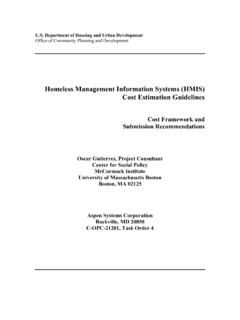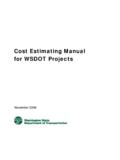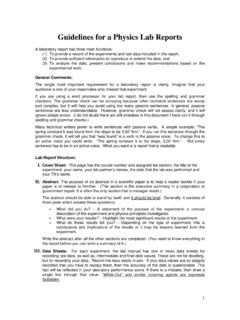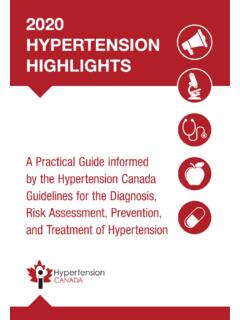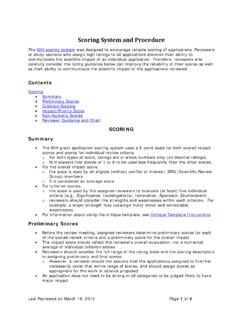Transcription of Estimation Guidelines and Templates - University of Edinburgh
1 Estimation Guidelines and Templates Introduction Why Estimate Projects? Estimation is an essential part of any project methodology. Estimation is used for a number of purposes: To justify the project, particularly at the proposal stage, enabling the costs to be compared with the anticipated benefits and to enable informed comparisons to be made between different technical or functional options. To enforce the disciplines needed to make the project succeed. To secure the resources required to successfully deliver the project. To ensure that the support impact of the project is fully understood. To inform and improve our software development process. This document describes the techniques of used to produce reliable estimates for the work required to complete projects and tasks.
2 A spreadsheet template for Three Point Estimation is available together with a Worked Example illustrating how the template is used in practice. Overview of the Estimation Process The best people to undertake Estimation are the staff who are going to do the work. The staff chosen to produce an estimate are typically drawn from IS, customers and/or service partners who have relevant experience of similar previous projects or tasks in the business area. Our Estimation process is based on three components: 1. Expert judgement, consultation with qualified experts from within IS and our business and service partners. This is supplemented, where required, by expert input from software suppliers and consultants.
3 2. Experience, comparison of the proposed project or task with previously completed work. 3. Task Decomposition, decomposing the project into components, a Work Breakdown Structure, and estimating each component individually to produce an overall estimate. The estimates are validated through peer review and are backed up by an experienced Project Manager who takes overall responsibility for the total. Estimates are reviewed and updated throughout the project lifecycle. Estimates, and the processes followed to produce them, are transparent and consistent across all projects. Project And Task Estimation Estimation Technique 1 - Three Point Estimation The Three Point Estimation technique is based on statistical methods, and in particular, the Normal distribution.
4 Three Point Estimation is the preferred Estimation technique for IS Applications projects. In Three Point Estimation we produce three figures for every estimate: a = the best case estimate m = the most likely estimate b = the worst case estimate These values are used to calculate an E value for the estimate and a Standard Deviation (SD) where: E = (a + (4*m) + b) / 6 SD = (b - a)/6 E is a weighted average which takes into account both the most optimistic and pessimistic estimates provided and SD measures the variability or uncertainty in the estimate. To produce a project estimate the Project Manager: 1. Decomposes the project into a list of estimable tasks, a Work Breakdown Structure 2.
5 Estimates each the E value and SD for each task. 3. Calculates the E value for the total project work as E (Project Work) = E (Task) 4. Calculates the SD value for the total project work as SD (Project Work) = SD (Task) 2 We then use the E and SD values to convert the project estimates to Confidence Levels as follows: Confidence Level in E value is approximately 50% Confidence Level in E value + SD is approximately 70% Confidence Level in E value + 2 * SD is approximately 95% Confidence Level in E value + 3 * SD is approximately IS Applications use the 95% Confidence Level for all project estimates. A spreadsheet template for Three Point Estimation is available together with a Worked Example illustrating how the template is used in practice.
6 Estimation Technique 2 - Base and Contingency Estimation Base and Contingency is an alternative Estimation technique to Three Point Estimation . It is less scientifically based and cannot be used to provide Confidence Levels. It can be a useful technique where there is less detail available on which to base the estimate. In Base and Contingency Estimation all estimates have two components the base and the contingency. The base is the minimum expected time required, when everything goes well. The contingency is the amount of trust placed on the base when risks are taken into account and is generally expressed as a percentage of the base. A figure of 10% -20% contingency is a typical figure rising to 50% or even greater for more risky tasks.
7 Separating the base and contingency makes the Estimation task easier. We can derive a base figure without having to take into account everything that might go wrong and then use risk analysis to determine the appropriate level of contingency. The assumptions that underpin the base estimate are recorded and the contingency reflects the confidence we have that these assumptions are correct. The Project Manager will also consider project wide risks and undertake a risk analysis to determine the correct amount of contingency to allow for them. These risks are recorded in the project Risk Log. The contingency is based on the maximum costs to the project of the risk occurring weighted by an assessment of how likely it is to occur expressed as a percentage.
8 Project contingency may be estimated in terms of money, resources or a mixture of both. Resource contingency is managed by adding a factor to individual task estimates. To produce a project estimate the Project Manager: 1. Decomposes the project into a list of estimable tasks, a Work Breakdown Structure 2. Estimates each task including any task contingency. 3. Adds the estimates together. 4. Adds the project contingency. Using this technique the Project Manager must be careful to avoid double-counting, adding contingency to both the project and task estimates for the same risk. Technical and Overhead Tasks Typically we will distinguish between the technical tasks of the project, for example code development or package configuration etc.
9 And overhead tasks such as project management or infrastructure support. Each technical task will be individually estimated whilst the estimate for each overhead tasks can often be calculated on a pro-rata basis. Key factors which will influence estimates for technical tasks are: size and complexity of the task the skills and experience of the development team and their familiarity with the technology being proposed (training may be required to enable members of the team to become productive with the technologies being used and gain familiarity with the business context - this can be estimated separately) non-functional requirements such as performance, reliability, code reusability etc.
10 Typical overhead tasks include: Project Management Quality Assurance Business Analysis Systems Analysis and Design Infrastructure Support Testing Deployment (includes user training and implementation in live environment.) Project experience suggests potentially useful rules of thumb for deriving initial estimates for various overhead tasks. These are provided in Table 1 below. Table 1 Rules Of Thumb for Estimating Overhead Tasks This approach simplifies Estimation and can provide a useful cross check of the technical estimates. However it is perfectly acceptable for overhead tasks to be decomposed and estimated separately where the Project Manager feels that this is more appropriate.
